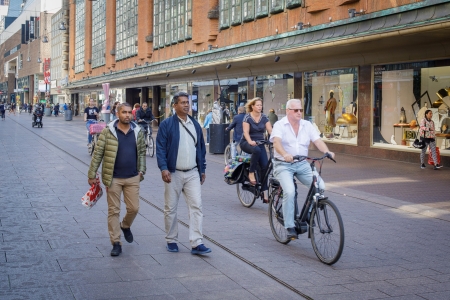Bicycle tracks are not only used by cyclists, but also by quite a lot of light-moped riders, and bicycle/moped tracks by moped riders as well. Speed and mass of the average (light-)moped rider differ considerably from that of the average cyclist [51] [55] and that is why these three modes of transport mostly determine the answer to the question to what extent speed, mass and size differences cause problems on bicycle tracks.
Early 2019, there were about 750,000 light mopeds, 450,000 mopeds and 17,000 speed pedelecs [2]. There are no statistics about cargo bikes. Their number seems to grow but, in a branch analysis, RAI Association [56] still calls it a niche market serviced by small manufacturers. Mopeds and light mopeds are over 50 kilos heavier and, including mirrors, 15 centimeters wider than pedelecs and bicycles. On bicycle tracks, light mopeds ride an average 32 km/h, approximately just as fast as mopeds before introduction of the Moped On the Carriageway measure in 1999 [51] [57]. So, light mopeds ride considerably faster than cyclists on ordinary bicycles (18 km/h) or pedelecs (21 km/h), see SWOV fact sheet Pedelecs and speed pedelecs.
The magnitude of the adverse road safety effect of these differences between vehicles on bicycle tracks is hard to quantify, but the evaluation of the Moped On the Carriageway measure showed that road safety improved after mopeds had been redirected from the bicycle track to the carriageway in urban areas in 1999. The number of road injuries in crashes with mopeds decreased by 15%. This not only concerns the moped riders themselves, but also pedestrians and cyclists who, as crash opponents, may also get injured. On bicycle tracks in the urban area, the number of crashes between moped riders and cyclists decreased and, at intersections, the number of crashes also decreased because, before the measure was introduced, drivers did not take account of high speeds of moped riders on bicycle tracks [39] [57] [58]. Outside the urban area, cyclists and moped riders still mingle on bicycle/moped tracks but, there, bicycle tracks are mostly quieter and the speed differences between mopeds and motor vehicles on the carriageway would be too great.
The question What is safer for light mopeds, carriageway or bicycle track? elaborates the consequences of speed and mass differences between light mopeds and other traffic. See SWOV fact sheet Pedelecs and speed pedelecs for differences between speed pedelecs and other traffic.
